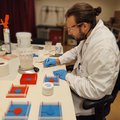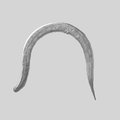 OK, people are still coming in and I see a LOT of new names, which is great. Let's get started! Welcome to Hack Chat, I'm Dan and I'll be moderating along with Dusan who'll be along a bit later. Today we welcome Krishna Sanka, who's doing some cool work with microfluidics for biohacking.
OK, people are still coming in and I see a LOT of new names, which is great. Let's get started! Welcome to Hack Chat, I'm Dan and I'll be moderating along with Dusan who'll be along a bit later. Today we welcome Krishna Sanka, who's doing some cool work with microfluidics for biohacking.
Hi Krishna! Can you start us off with a little about your background?
![]() there no sound in this chat?
there no sound in this chat?
 No, this is a text chat, like a reddit AMA
No, this is a text chat, like a reddit AMA
![]() thanks
thanks
 Hi All ! My name is Radhakrishna (aka Krishna). I'm currently a Ph.D. candidate at Boston University working on how we can simplify and automate the design of microfluidic devices for applications in synthetic biology and beyond. What this roughly translates to is that I create a whole bunch of CAD tools and go about telling microfluidics designers that they're going about everything the wrong way :D
Hi All ! My name is Radhakrishna (aka Krishna). I'm currently a Ph.D. candidate at Boston University working on how we can simplify and automate the design of microfluidic devices for applications in synthetic biology and beyond. What this roughly translates to is that I create a whole bunch of CAD tools and go about telling microfluidics designers that they're going about everything the wrong way :D
![]() So you're an engineer
So you're an engineer
 Before coming into the world of microfluidics I spent some time designing electronics, software and photonics. So I have a bunch of experience on using CAD tools.
Before coming into the world of microfluidics I spent some time designing electronics, software and photonics. So I have a bunch of experience on using CAD tools.
 hello! What kind of devices are you working on now?
hello! What kind of devices are you working on now?
 @Nicolas Tremblay yes I'm an engineer !
@Nicolas Tremblay yes I'm an engineer !
 Microfluidics has appealed to me for quite some time. But I always wondered what I, a hobbist Maker, could apply it to. Since Microluidics is your Hammer do you see a lot of nails. Any unexpected stuff you suddenly realized could be done via it??
Microfluidics has appealed to me for quite some time. But I always wondered what I, a hobbist Maker, could apply it to. Since Microluidics is your Hammer do you see a lot of nails. Any unexpected stuff you suddenly realized could be done via it??
 @bluevex my colleagues and collaborators are working :
@bluevex my colleagues and collaborators are working :
1) Droplet based devices for yeast and ecoli
2) Droplet based devices for microbiome
3) Single Cell imaging (e.coli)
 @rkrishnasanka are the CAD tools you develop these days open source?
@rkrishnasanka are the CAD tools you develop these days open source?
 Over these projects, we end up fabricating microfluidics via:
Over these projects, we end up fabricating microfluidics via:
1) CNC milling
2) Laser Cutting
3) Photolithography
 Yes, they are open source!
Yes, they are open source!
 not 3d printing?
not 3d printing?
 Any "cultural" issues between you as an engineer and the scientists you work with? My background is in biology, so I could see where there might be some friction.
Any "cultural" issues between you as an engineer and the scientists you work with? My background is in biology, so I could see where there might be some friction.
 You mentioned the CAD tools - which ones do you use? Also, tell us more about the pitfalls of the microfluidics designers you describe above.
You mentioned the CAD tools - which ones do you use? Also, tell us more about the pitfalls of the microfluidics designers you describe above.
 I have been deep diving into consumer/lab microfluidic devices for constant delivery microfluids. (For my purposes I am colouring forsting. ) Have you looked at peizoelectric micro pump delivery systems?
I have been deep diving into consumer/lab microfluidic devices for constant delivery microfluids. (For my purposes I am colouring forsting. ) Have you looked at peizoelectric micro pump delivery systems?
 even on formLabs with all their detail?
even on formLabs with all their detail?
 @Les Hall not yet, we are hoping to have some collabs by the end of the year with 3d printing
@Les Hall not yet, we are hoping to have some collabs by the end of the year with 3d printing
 ty
ty
 @Dan Maloney yup, we face this a lot. Scientists care about the single killer experiments (in biology) or the n-th unique variation of a microfluidic geometry. They don't care about building working replicable systems.
@Dan Maloney yup, we face this a lot. Scientists care about the single killer experiments (in biology) or the n-th unique variation of a microfluidic geometry. They don't care about building working replicable systems.
 Are there any development with metal 3D printers making the molds for the, what do you call those cubes, chips, chambers, channels?? Since metal 3D printing is done via laser sintering
Are there any development with metal 3D printers making the molds for the, what do you call those cubes, chips, chambers, channels?? Since metal 3D printing is done via laser sintering
 I don't really blame them because you won't get your nature paper with just reliable microfluidics, its not boogie enough for that
I don't really blame them because you won't get your nature paper with just reliable microfluidics, its not boogie enough for that
 @John Uskglass yes the new pumps look really cool. I, unfortunately, haven't had a chance to play with those yet.
@John Uskglass yes the new pumps look really cool. I, unfortunately, haven't had a chance to play with those yet.
 I'd love to use them for some of my next hardware projects, right now I'm grinding out software
I'd love to use them for some of my next hardware projects, right now I'm grinding out software
 @radiologyrocks While I work on my own tools for designing microfluidics, I typically use fusion360 when I need to make a quick prototype when I don't have the standard components in my design tools.
@radiologyrocks While I work on my own tools for designing microfluidics, I typically use fusion360 when I need to make a quick prototype when I don't have the standard components in my design tools.
 @radiologyrocks the pitfalls of using mechanical design tools is that you'll lose your sanity after a couple of components and essentially what you're making is a drawing rather than designing a functional system.
@radiologyrocks the pitfalls of using mechanical design tools is that you'll lose your sanity after a couple of components and essentially what you're making is a drawing rather than designing a functional system.
 I need to create custom microfluidic CAD software (In python ideally), would you recommend your current stack or would you try something differently today?
I need to create custom microfluidic CAD software (In python ideally), would you recommend your current stack or would you try something differently today?
 Most microfluidics folks are hardcore mechanical engineers and they don't think "
Most microfluidics folks are hardcore mechanical engineers and they don't think "
systems"
 Krishna, how did you learn about how to do things? Is there a textbook, or a just a collection of methods papers?
Krishna, how did you learn about how to do things? Is there a textbook, or a just a collection of methods papers?
 @John Uskglass what kind of software ?
@John Uskglass what kind of software ?
 I'd love it if you could use my stack (python and javascript). We genuinely want more people help build out the software in this space
I'd love it if you could use my stack (python and javascript). We genuinely want more people help build out the software in this space
 @rkrishnasanka if I want to do a microfluidics project in my makerspace, what would you recommend as useful and achievable.
@rkrishnasanka if I want to do a microfluidics project in my makerspace, what would you recommend as useful and achievable.
 @Inne Laser cutting is the easiest approach IMO
@Inne Laser cutting is the easiest approach IMO
![]() where is your opensource tools available? do you have descriptions?
where is your opensource tools available? do you have descriptions?
 It'll take a couple of tries to get it right but that seems to be most cost effective approach when you want to dip your toes into it
It'll take a couple of tries to get it right but that seems to be most cost effective approach when you want to dip your toes into it
 Laser cutting pathways?
Laser cutting pathways?
 I work on almost all the tools listed here : https://www.cidarlab.org/microfluidics
I work on almost all the tools listed here : https://www.cidarlab.org/microfluidics
![]() are your microfluidics optics based
are your microfluidics optics based
 @rkrishnasanka wait how do you laser cut them. From what kind of material.
@rkrishnasanka wait how do you laser cut them. From what kind of material.
 @Inne you can lasercut acrylic for this
@Inne you can lasercut acrylic for this
 ah
ah
 Yeah you laser cut the geometries. infact one of my design tool 3DuF (https://3duf.org) will generate the lasercutting SVGs
Yeah you laser cut the geometries. infact one of my design tool 3DuF (https://3duf.org) will generate the lasercutting SVGs
 So if you have things like valves and whatnot, it'll generate separate the SVGs for you to cut on different substrates
So if you have things like valves and whatnot, it'll generate separate the SVGs for you to cut on different substrates
 You have to generate g-code that allows users to input which locations gives how much fluid. I am wondering how this is achieved. Somehow you take the requirements for a test and you generate g-code output. (Lets say 10x10 test tube array.) Is it just python api calls to call for a test at a location? ( This is a bit messy.)
You have to generate g-code that allows users to input which locations gives how much fluid. I am wondering how this is achieved. Somehow you take the requirements for a test and you generate g-code output. (Lets say 10x10 test tube array.) Is it just python api calls to call for a test at a location? ( This is a bit messy.)
 Oh thats very cool. Do you have any application you can recommend trying to build first
Oh thats very cool. Do you have any application you can recommend trying to build first
![]() do you have any suggestions or recommendations for micropumps?
do you have any suggestions or recommendations for micropumps?
 @John Uskglass hmm I might need more info but if you use 3DuF you should be able to create the designs that will accommodate loading the required volumes at specific locations. (If I understand you correctly)
@John Uskglass hmm I might need more info but if you use 3DuF you should be able to create the designs that will accommodate loading the required volumes at specific locations. (If I understand you correctly)
 @empil some of the piezo pumps look really promising but they're super pricy (and not worth it if you don't need really precise volume dispensation). I'm thinking of using these for my next project (https://www.bartels-mikrotechnik.de/)
@empil some of the piezo pumps look really promising but they're super pricy (and not worth it if you don't need really precise volume dispensation). I'm thinking of using these for my next project (https://www.bartels-mikrotechnik.de/)
![]() What would be the equivalent of "hello world" in microfluidics experiments?
What would be the equivalent of "hello world" in microfluidics experiments?
 But if you wanna go the DIY way and low-cost, check out https://hackaday.io/project/27511-microfluidics-control-system
But if you wanna go the DIY way and low-cost, check out https://hackaday.io/project/27511-microfluidics-control-system
 @Inne @gonzalo I would recommend that you folks try to recreate some designs from http://2017.igem.org/Team:BostonU_HW/IntrouF
@Inne @gonzalo I would recommend that you folks try to recreate some designs from http://2017.igem.org/Team:BostonU_HW/IntrouF
 This project was done by some of my undergrad mentees and they went from zero to hero in microfluidics in 1 summer (they made about 100 devices)
This project was done by some of my undergrad mentees and they went from zero to hero in microfluidics in 1 summer (they made about 100 devices)
 I've thought of using glass and silicates to bond glass layers. Anyone else thinking glass?
I've thought of using glass and silicates to bond glass layers. Anyone else thinking glass?
 Do you need specifically PDMS or will "normal" platinum silicone also work.
Do you need specifically PDMS or will "normal" platinum silicone also work.
 3DuF doesn't support some the older design files now, but that gives you a reason to recreate those devices, though you all should try using laser cutters instead of CNC milling as shown in that project
3DuF doesn't support some the older design files now, but that gives you a reason to recreate those devices, though you all should try using laser cutters instead of CNC milling as shown in that project
 I ran into with trying to drive fluids in these chambers. The pressure requirements were too high. How do I avoid this mistake? It seems iterating is enough
I ran into with trying to drive fluids in these chambers. The pressure requirements were too high. How do I avoid this mistake? It seems iterating is enough
 @Inne I think silicone would work, main issue is getting the right thickness that will bend nicely. You can buy PDMS in bulk sheets online
@Inne I think silicone would work, main issue is getting the right thickness that will bend nicely. You can buy PDMS in bulk sheets online
 @John Uskglass I see sometimes we use syringe pumps so that we can drive the fluids with fairly high pressure.
@John Uskglass I see sometimes we use syringe pumps so that we can drive the fluids with fairly high pressure.
 @rkrishnasanka It was more that I always thought PDMS was pretty expensive and I already have a lot of silicone (for soft robotics)
@rkrishnasanka It was more that I always thought PDMS was pretty expensive and I already have a lot of silicone (for soft robotics)
 But getting the good stuff might be nice to start with.
But getting the good stuff might be nice to start with.
![]() (~$130 gets you a LOT of PDMS)
(~$130 gets you a LOT of PDMS)
 @Inne if you buy the mix, PDMS will be expensive, but I believe sheets are a lot cheaper
@Inne if you buy the mix, PDMS will be expensive, but I believe sheets are a lot cheaper
 https://prnt.sc/19b7bh5 Made using a SLA printer.
https://prnt.sc/19b7bh5 Made using a SLA printer.
 oh good to know
oh good to know
 You can use silicone too, I'm guess the the aspect ratios for the channels and valve areas will need to change though
You can use silicone too, I'm guess the the aspect ratios for the channels and valve areas will need to change though
![]() What would you suggest for fluid handling systems? Syringe pumps, pressure driven, perisaultic etc
What would you suggest for fluid handling systems? Syringe pumps, pressure driven, perisaultic etc
 @isaac depends on the application, if you're characterizing stuff you want to use syringe pumps, the more expensive the better (the cost and calibration makes all the difference)
@isaac depends on the application, if you're characterizing stuff you want to use syringe pumps, the more expensive the better (the cost and calibration makes all the difference)
![]() For the makerspace or DIY'er, do you think its worth it to shell out the money on a syringe pump, vs make one yourself?
For the makerspace or DIY'er, do you think its worth it to shell out the money on a syringe pump, vs make one yourself?
 If you're doing millifluidic, peristatic is good. The hardware stack used by https://www.fynchbio.com/ is pretty good, and DIY friendly
If you're doing millifluidic, peristatic is good. The hardware stack used by https://www.fynchbio.com/ is pretty good, and DIY friendly
 How do you do your testing to measure how mixed the fluids are? Flow rate? Is there openCV stuff involved ?
How do you do your testing to measure how mixed the fluids are? Flow rate? Is there openCV stuff involved ?
 Yeah, we used openCV for measuring mixing. But this only works when the fluids have dyes in them
Yeah, we used openCV for measuring mixing. But this only works when the fluids have dyes in them
 Actually you can also use imageJ
Actually you can also use imageJ
 It seems to enough plugins to do the job and calculate the color gradient
It seems to enough plugins to do the job and calculate the color gradient
![]() What do you think the killer app in maker-level microfluidics will be?
What do you think the killer app in maker-level microfluidics will be?
 "Continuous culture devices" - I'm ashamed to say that I haven't built one yet but this is stuff everyone will use
"Continuous culture devices" - I'm ashamed to say that I haven't built one yet but this is stuff everyone will use
 @isaac lavalamps NO ... Lava clocks.
@isaac lavalamps NO ... Lava clocks.
 We had someone on the 3DuF slack who was building continuous culture devices using tesla valves
We had someone on the 3DuF slack who was building continuous culture devices using tesla valves
 that's not such a bad idea perhaps... working household demonstrators...
that's not such a bad idea perhaps... working household demonstrators...
 Have you done any testing for nL sized droplets? I've seen a few people hack old printers but it seems all the companies with those heads keep their technology under wraps.
Have you done any testing for nL sized droplets? I've seen a few people hack old printers but it seems all the companies with those heads keep their technology under wraps.
 Because he was 3D printing
Because he was 3D printing
 @John Uskglass one of my colleagues, Ali build an entire tool for doing inverse design of droplet generation devices. checkout (https://dafd.org). you just plug in the values for the droplet sizes and generation rates and it will plop out a design that will open in 3DuF.
@John Uskglass one of my colleagues, Ali build an entire tool for doing inverse design of droplet generation devices. checkout (https://dafd.org). you just plug in the values for the droplet sizes and generation rates and it will plop out a design that will open in 3DuF.
![]() dafdcad.org maybe?
dafdcad.org maybe?
 Tesla valves as in Tesla car patents?
Tesla valves as in Tesla car patents?
 oops dafdcad.org
oops dafdcad.org

https://www.youtube.com/watch?v=suIAo0EYwOE
 ^^^ thats a tesla valve
^^^ thats a tesla valve
 It acts like a fluidic diode
It acts like a fluidic diode
 the tesla valve I made worked just fine
the tesla valve I made worked just fine
 @Les Hall thats awesome !
@Les Hall thats awesome !
 What are you using it for ?
What are you using it for ?
 it was large and worked on air though
it was large and worked on air though
 Ah !
Ah !
![]() Not sure if you can talk vendors but... Any leads on a good source for PDMS sheets? I pour my own right now and its pretty labor intensive
Not sure if you can talk vendors but... Any leads on a good source for PDMS sheets? I pour my own right now and its pretty labor intensive
 @isaac , I feel you! TBH I made everyone else do it the pouring. I need to check whom we are ordering from. Leave me a DM and I'll get back to you on that
@isaac , I feel you! TBH I made everyone else do it the pouring. I need to check whom we are ordering from. Leave me a DM and I'll get back to you on that
 Or post it here since more people seem to be interested in them
Or post it here since more people seem to be interested in them
![]() Yes, some sources for the materials would be great!
Yes, some sources for the materials would be great!
 I've thought of small diaphragm pumps that close off the opening some as they pump out, so a chain of them in series can pump with substantial pressure. Could be driven by tiny solenoids.
I've thought of small diaphragm pumps that close off the opening some as they pump out, so a chain of them in series can pump with substantial pressure. Could be driven by tiny solenoids.
![]() Cool cool, will do. It's easily 90% of the device fab time for me right now lol
Cool cool, will do. It's easily 90% of the device fab time for me right now lol
 Small as in 3mm across.
Small as in 3mm across.
 @John Uskglass Yeah, those are cool, one of the postdocs in our lab uses those, I'll check with him and see what dimensions and delays are working for him.
@John Uskglass Yeah, those are cool, one of the postdocs in our lab uses those, I'll check with him and see what dimensions and delays are working for him.
 @Dan Maloney maybe at it later in the transcript otherwise it will there forever on the internet to contact
@Dan Maloney maybe at it later in the transcript otherwise it will there forever on the internet to contact
 Dan Maloney
Dan Maloney
Discussions
Become a Hackaday.io Member
Create an account to leave a comment. Already have an account? Log In.